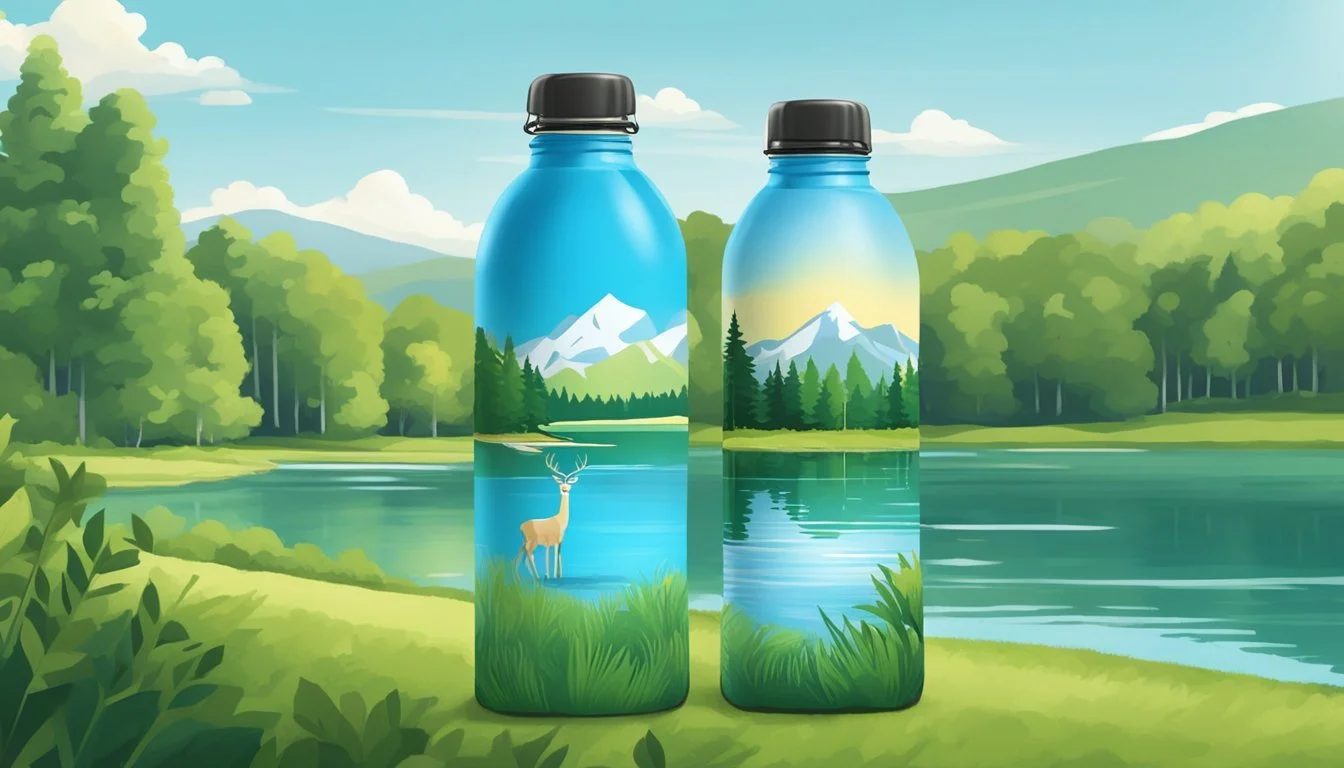Deer Park vs. Crystal Lake
A Comparative Analysis of Bottled Water Brands
When it comes to choosing between Deer Park and Crystal Lake bottled water, many consumers are curious about which brand stands out. Both brands are known for their distinct qualities and target audiences who value different aspects of bottled water. Deer Park is praised for its crisp, clean taste and commitment to sustainability, while Crystal Lake boasts a mineral-rich profile that some find particularly refreshing.
For those who prioritize taste and purity, Deer Park often comes out on top. The brand's focus on sourcing water from natural springs in the Appalachian Mountains ensures a reliably pure product. This has made Deer Park a preferred choice for many who seek high-quality bottled water without potential contaminants.
On the other hand, Crystal Lake is distinguished by its mineral-rich content, which adds a unique flavor that appeals to a specific segment of water enthusiasts. This difference in composition provides a noticeable contrast to Deer Park, catering to those who enjoy a more pronounced mineral taste in their water.
Understanding Bottled Water
Bottled water is a popular choice for hydration, offering various attributes based on the source and type of water. This section delves into what defines bottled water, its potential sources, and the different types available in the market.
Defining Bottled Water
Bottled water is packaged drinking water available in various forms such as spring water, purified water, and alkaline water.
The FDA regulates bottled water, ensuring it meets safety standards. Bottled water can come from a variety of sources, each providing a different taste and mineral content. The water is often marketed under various brands like Deer Park, Crystal Lake, and others, distinguishing themselves with unique attributes and processing methods.
Sources of Bottled Water
There are many sources for bottled water, including natural springs, artesian wells, and even municipal supplies.
Natural spring water and mountain spring water are often prized for their purity and mineral content. Brands like Deer Park often source their water from springs in the Eastern Seaboard of the United States. Purified water is another common source where water undergoes a rigorous filtration process to remove contaminants.
Types of Bottled Water
Bottled water can be categorized into several types:
Spring Water: Originates from underground formations and flows naturally to the surface.
Purified Water: Undergoes processes like distillation, deionization, or reverse osmosis.
Alkaline Water: Has a higher pH level and is said to neutralize acid in the body.
Sparkling Water: Contains dissolved carbon dioxide gas, making it fizzy.
100% natural spring water is marketed for its untouched quality, emphasizing its direct source. Brands like Crystal Lake offer this type of water, ensuring its natural properties are maintained from source to bottle.
Comparing Deer Park and Crystal Lake
Deer Park and Crystal Lake are two well-known bottled water brands, each with its unique characteristics. This section examines key aspects of these brands, including their origins, water sources, taste profiles, and quality standards.
Brand Overview
Deer Park is a Nestlé-owned brand that markets itself as being sourced from 100% natural springs. It has a significant presence across the Eastern Seaboard. The brand emphasizes its commitment to providing natural spring water with a clean and crisp taste.
Crystal Lake, in comparison, is a smaller, regionally-focused brand. It prides itself on local sourcing and aims to cater to a niche market looking for premium-quality water with minimal processing. Crystal Lake often highlights its local heritage and commitment to sustainable practices.
Water Source and Origin
Deer Park sources its water from multiple springs located in the Eastern United States. This diverse sourcing is claimed to ensure consistency and purity in their water. Deer Park highlights that their water maintains natural minerals from these spring sources.
Crystal Lake obtains its water from a single, well-protected aquifer. Located in a pristine area, the source of Crystal Lake’s water is chosen for its unique mineral composition and low levels of industrial contaminants. This single-source approach aims to offer a consistent taste and high purity in every bottle.
Taste and Flavor Profile
Deer Park water is often described as having a crisp and clean taste. This flavor profile is attributed to the natural mineral content that remains after minimal processing. Consumers tend to appreciate the refreshing quality of Deer Park, noting that it pairs well with various meals and activities.
Crystal Lake water has a slightly more distinctive taste, likely due to the unique mineral balance of its single-source aquifer. The flavor is smooth and may have subtle notes that set it apart from other bottled waters. Crystal Lake markets its taste as premium, often appealing to consumers looking for a high-quality hydration experience.
Quality and Purity
Deer Park follows rigorous quality control measures to ensure the water is pure and safe to drink. The brand is transparent about its testing processes, which include regular checks for contaminants and adherence to industry standards. Deer Park also highlights its efforts in sustainable practices, including eco-friendly packaging.
Crystal Lake emphasizes purity through its minimal processing and careful selection of its water source. The brand often showcases its water's low levels of contaminants and high natural mineral content. Crystal Lake is committed to sustainability, employing practices that minimize environmental impact and promote the preservation of their natural source.
Each brand offers unique attributes that cater to different consumer preferences, making the choice between Deer Park and Crystal Lake largely dependent on individual tastes and values.
Safety and Compliance
Both Deer Park and Crystal Lake must adhere to strict standards to ensure their bottled water is safe for consumption. This involves meeting FDA regulations and testing for various contaminants and chemicals.
FDA Regulations and Compliance
Deer Park and Crystal Lake are required to comply with FDA regulations, which are designed to ensure the safety and quality of bottled water. The FDA sets limits for contaminant levels, consistent with the standards set by the Environmental Protection Agency (EPA) for tap water.
Compliance involves regular testing and maintaining detailed quality reports. These reports often include information on the water source, treatment methods, and results of purity tests. Each brand must ensure that they meet these regulatory standards to avoid penalties and ensure consumer safety.
Contaminants and Chemical Analysis
Testing for contaminants in bottled water is crucial. Both Deer Park and Crystal Lake monitor for PFAS chemicals, lead, arsenic, and other potentially harmful substances. Recent reports highlighted the presence of PFAS in some bottled water brands, raising concerns about long-term safety.
To ensure safe drinking water, Deer Park conducts regular analyses to detect and quantify these chemicals. Crystal Lake follows a similar protocol, adhering to both FDA and additional voluntary standards. By doing so, they aim to provide consumers with confidence in the safety and purity of their bottled water products.
Environmental Impact
Evaluating the environmental impact of bottled water brands, like Deer Park and Crystal Lake, involves understanding their bottling processes and the initiatives they have for plastic waste and recycling.
Bottling Process and Carbon Footprint
The bottling process greatly influences the environmental footprint of water brands. Deer Park sources its water from springs along the Eastern Seaboard, which requires transportation and processing. This contributes to its carbon footprint through emissions from transportation and bottling facilities.
Crystal Lake also involves significant transportation needs, especially if the water is sourced from distant locations. The energy consumption for purification, filtration, and bottling adds to the overall carbon emissions. Companies can reduce their carbon footprint by streamlining their supply chain and utilizing renewable energy sources.
Plastic Waste and Recycling Initiatives
Plastic waste from single-use bottles poses a significant environmental challenge. Deer Park and Crystal Lake primarily use single-use plastic bottles made from petroleum-based plastics. These bottles contribute to the growing problem of plastic pollution if not properly recycled.
Both brands have initiatives to mitigate this impact. Deer Park has invested in increasing the recyclability of its packaging and promoting BPA-free plastic. Crystal Lake focuses on sustainability efforts, such as using recycled materials for their bottles. Encouraging consumers to recycle and providing accessible recycling programs are crucial steps both companies are taking to address plastic waste.
Consumer Considerations
When choosing between Deer Park and Crystal Lake bottled water, important factors include packaging alternatives and the transparency of brand labeling.
Packaging and Product Availability
Deer Park offers a variety of packaging options, including plastic bottles, glass bottles, and even 5-gallon jugs for home delivery. The brand provides spring water regarded for its crisp taste. Consumers find Deer Park easily accessible in most grocery stores along the Eastern Seaboard, as well as major retail chains.
Crystal Lake primarily distributes its water in sustainable packaging such as boxed water and recyclable plastic bottles. This brand emphasizes environmental responsibility, often highlighted in their marketing. Crystal Lake is also widely available but may be more prominent in specialty health food stores and organic markets.
Labeling and Brand Transparency
Deer Park labels provide clear information on the water source and composition. The brand claims 100% natural spring water, sourced from multiple springs. Regularly updated reports on water quality are available online, enhancing their credibility.
Crystal Lake takes an equally transparent approach, clearly listing water sources and purity levels on their labels. The brand's commitment to sustainability includes detailed information about their eco-friendly packaging. Crystal Lake's website offers extensive reports reviewed by investigative journalists to ensure accuracy.
Both brands excel in providing necessary information to the consumers, but their focus areas differ, reflecting their brand ethos and consumer base.
More About Deer Park
Deer Park vs Cascade Mountain: Which Bottled Water is Better?
Deer Park vs Hawaii Volcanic: Which Bottled Water is Better?
Deer Park vs Hawaiian Springs: Which Bottled Water is Better?
Deer Park vs Icelandic Glacial: Which Bottled Water is Better?
Deer Park vs Kirkland Signature: Which Bottled Water is Better?
Deer Park vs Mountain Valley Spring Water: Which Bottled Water is Better?
Deer Park vs Nestle Pure Life: Which Bottled Water is Better?
Deer Park vs Richard's Rainwater: Which Bottled Water is Better?
Deer Park vs Solan de Cabras: Which Bottled Water is Better?
Deer Park vs Talking Rain AQA: Which Bottled Water is Better?
Deer Park vs Whole Foods 365: Which Bottled Water is Better?
Deer Park vs Whole Foods Italian Still Mineral water: Which Bottled Water is Better?
More About Crystal Lake
Aqua Carpatica vs Crystal Lake: Which Bottled Water is Better?
Cascade Mountain vs Crystal Lake: Which Bottled Water is Better?
Core Hydration vs Crystal Lake: Which Bottled Water is Better?
Crystal Geyser vs Crystal Lake: Which Bottled Water is Better?
Crystal Lake vs Essence pH10: Which Bottled Water is Better?
Crystal Lake vs Proud Source: Which Bottled Water is Better?
Hawaii Volcanic vs Crystal Lake: Which Bottled Water is Better?
Hawaiian Springs vs Crystal Lake: Which Bottled Water is Better?
Ice Mountain vs Crystal Lake: Which Bottled Water is Better?
Icelandic Glacial vs Crystal Lake: Which Bottled Water is Better?
Kirkland Signature vs Crystal Lake: Which Bottled Water is Better?
Liquid Death vs Crystal Lake: Which Bottled Water is Better?
Mountain Valley Spring Water vs Crystal Lake: Which Bottled Water is Better?
Nestle Pure Life vs Crystal Lake: Which Bottled Water is Better?
Poland Spring vs Crystal Lake: Which Bottled Water is Better?
Purely Sedona vs Crystal Lake: Which Bottled Water is Better?
Richard's Rainwater vs Crystal Lake: Which Bottled Water is Better?
San Pellegrino vs Crystal Lake: Which Bottled Water is Better?
Simple Truth vs Crystal Lake: Which Bottled Water is Better?
Solan de Cabras vs Crystal Lake: Which Bottled Water is Better?
Talking Rain AQA vs Crystal Lake: Which Bottled Water is Better?
Whole Foods 365 vs Crystal Lake: Which Bottled Water is Better?
Whole Foods Italian Still Mineral water vs Crystal Lake: Which Bottled Water is Better?




